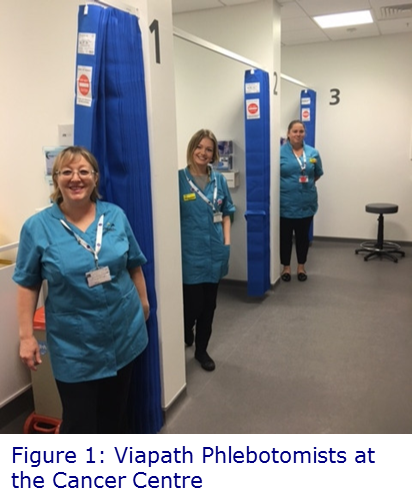Guy’s Hospital Opens a New Cancer Centre
Designed by Patients for Patients
On September 26th, one of Viapath’s founding trust hospitals, Guy’s Hospital, opened the doors to a new state of the art Cancer Centre. This patient- centred, clinically-led and research driven centre represents a significant leap in the journey to transform cancer treatment, care and research by encompassing the majority of Guy’s and St Thomas’ cancer treatments and research into a single building.
During the planning and design of the building there was significant staff involvement from medical, nursing and scientific backgrounds as well as patients. This has resulted in a state of the art Cancer Centre that puts patients first. The building is divided into 4 villages; the Welcome Village, Radiotherapy Village, Outpatients Village and the Chemotherapy Village, represented by the needs of patient treatment and management pathway.
How Are Viapath Involved in the Treatment of Patients in the Cancer Centre?
Viapath will be playing a key role in the treatment of patients by providing an on site dedicated phlebotomy and haematology testing service via a mini lab.
As front line staff, Viapath phlebotomists are only too aware of the fact that behind every test there is a patient. The Phlebotomy department provides a service on the Ground Floor of the Welcome Village between the hours of 08.00 and 18.30 Monday to Thursday and till 15.30 on a Friday. In addition to being bled via a direct venous method, Cancer Centre patients are bled from either a peripherally inserted central catheter (PICC) or a central venous catheter (Hickman Line) which is often used for administrating chemotherapy and other medicines.
All Full Blood Count Samples are run within minutes by the Viapath Haematology mini lab, so that the results are available for other clinical staff to see before the patients consultations. The remaining Blood Sciences samples are processed urgently by the laboratories at Guys Hospital so that if the patient needs to have treatment the same day then appropriate decisions can be made.
More recently, Viapath’s “Mohs” Service, one of the largest units within the UK, moved into the new Cancer Centre within the dermatological laser surgery unit housed in the Outpatient’s Village to support the holistic approach to patient care. The Mohs Service was fully operational by the end of October and the unit looks forward to building the service in the future to reflect a centre of excellence provision for Mohs within the UK
What is Mohs Surgery?
Mohs micrographic surgery is a specialised method for removing certain types of skin cancer and was first developed by Frederic Mohs in the 1930s.
Over the last decade in the UK (between 2002-2004 and 2011-2013) malignant melanoma incidence rates in males and females have increased by 46% (Cancer Research UK). Traditionally, operations for treating skin cancer surgically have involved removal of the area affected by the skin cancer together with an area of healthy unaffected skin, around and below the skin cancer in order to remove the entire cancer.
Mohs micrography surgery is often used for the removal of a type of common skin cancer known as a basal cell carcinoma (BCC) but often recommended for the removal of other types of skin cancer, for example squamous cell carcinoma (SCC) and lentigo maligna melanoma (LMM) as these types frequently arise on the head and neck areas where minimising surgical wounds is important. The Mohs Service is a highly effective method for removing skin cancers and has a cure rate of 99% for primary (new) tumours and 95% for recurrent tumours (British Association of Dermatologists, 2016).
How is Mohs Surgery Performed?
The Viapath laboratory specialises in Mohs and slow Mohs micrographic surgery techniques for the removal of skin cancers. The procedure is a very precise and detailed method which involves the skin cancer being removed a thin layer at a time, with a small margin of healthy skin surrounding it, keeping the wound as small as possible. Each layer of skin is removed and examined under a microscope in horizontal sections until all of the cancer has been fully removed. This method allows the patient and the surgeon to be almost certain that the skin cancer has been removed on that day, rather than waiting the 2 weeks it takes for traditional surgically removed skin cancer results.
Fulfilling the Vision
“The Cancer Centre operational team and Viapath worked in partnership to provide an enhanced blood testing service in the Cancer Centre. Viapath representatives were instrumental in the current design of the service that is now in place. The aim is to bleed all patients within 15 minutes and ensure all FBCs are turned around in 15 minutes so that the results are available to clinicians in clinic. This will improve patient experience through shorter waits and with the FBC results now available in clinic to inform the consultation. Together we will strive to further improve the experience for patients and clinical team.” Dr Majid Kazmi; Consultant Haematologist, Guy's and St Thomas' NHS Trust and King's College Hospital


